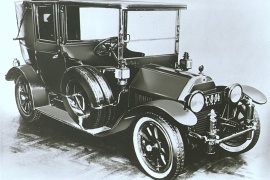
LANCIA Gamma
Generations Timeline, Specs and Pictures

Lancia had already made tradition with naming its models after the Greek alphabet letters.
Thus, the Lancia Gamma was designed to replace the Lancia Beta.
Also known as the Lancia 20 HP or the Lancia Tipo 55, the passenger vehicle was produced by the Italian carmaker between 1910 and 1911.
The new Gamma was differentiated from the Lancia Beta by an increase in displacement, the engine capacity getting up to 3460 cc. The engine was a side valve inline-four, with a cast-iron monobloc.
The powerplant produced 40 hp at 1500 rpm and was mated with a 4-speed gearbox that sent the power to the real wheels. With the Lancia Gamma , the driver could reach a decent top speed of 110km/h (68 mph).
For the customers looking to participate in competitions, the Gamma was also available with a bigger engine, a 4.7-liter unit that developed more than 50 hp.
Buyers also had possibility of choosing between frames of different configurations: the wheelbase measurements could vary (like the degrees of inclination of the steering column and the final transmission ratio) depending on the types of bodywork to be mounted.
The separate body of the car was built on a ladder frame, while braking was by drums.
With only one year in production, only 258 units were produced before the Gamma was later replaced by the Lancia Delta in 1911.

Lancia introduced the Gamma in 1976 as its flagship model in a desperate attempt to survive on a market that started to look too much at fuel-efficiency and less at handling.
The Italian carmaker was already purchased by Fiat and still tried to make the cars the way it knew. Up to some point, Fiat was fine with that. But it couldn’t allow Lancia to build vehicles that might compete against other Fiats on the market. That said, Lancia developed its executive sedans (named Berlina) as fastbacks, while Fiat built sedans and station wagons.
Lancia employed Pininfarina studios to design its Gamma lineup, and the prolific designer made it resemble a sports car. Its low nose and raked windshield didn’t look like an ordinary family sedan. Its fastback rear end resembled the look of a Citroen DS. At the front, the Gamma sported two double headlights and pointing down pentagonal chromed trim. Strangely, the Lancia shield was very small compared to the grille’s size. The chromed flush to bodywork door handles were designed for a more aerodynamic profile and lower the wind noise on the sides.
Inside, the Gamma was very roomy, and the dashboard amplified the spacious car feeling thanks to its flat areas and angled-down panel. Its instrument cluster was squared and raised above the center stack and continued to the car’s outer side, next to the driver area. It covered the stereo and the climate control unit, while the instrument cluster was filled with two large dials and four gauges.
Under the hood, the flat-four engines offered by Lancia were nowhere near as smooth as the V-6s or V-8s offered by its main rivals. But it managed to survive on the market until 1984 when the Thema replaced it.























































